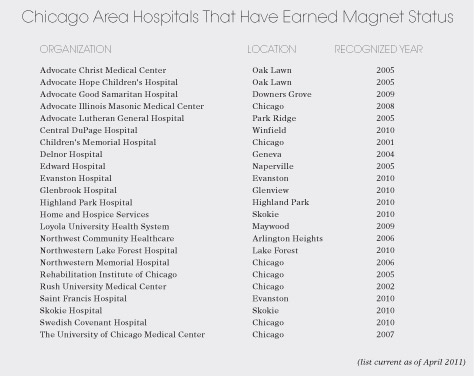How the Magnet Recognition Program for nurses affects your hospital
When we think about what makes for a great hospital, we tend to think about the doctors, the equipment and even the cost. And, nurses? Well, we just hope they’re not too overworked and grumpy to get the doctor and morphine when we need them.
But, the role of a nurse goes much deeper than that. “The nurse is with the patient more than anyone else,” says Karen Lamb, an associate professor at Rush University’s College of Nursing. Nurses take medical histories, monitor and manage the vitals and symptoms of patients and relay that information among a team of doctors. “They’re the ones who are going to be picking up minute changes,” Lamb says.
Still, good nurses are more than supermoms (or dads) who know and micromanage the logistics. They actively shape a patient’s medical care, constantly adjusting treatment, based on their observations and knowledge. “Nurses are educated, not [only] trained,” says Lamb. And, in a chaotic setting like a hospital, good nurses are critical to good patient care.
So, how do you know which hospitals have the best-educated nurses?
“The first thing you have to look for is Magnet status,” says Kathy O’Donnell, who has worked as a registered nurse at St. Margaret Mercy Hospital in Hammond, Indiana, for 27 years.
The Magnet Recognition Program was born out of a national shortage of nurses in the 1980s. When some hospitals weren’t affected by the shortage, the American Academy of Nursing sent a task force to find out how these hospitals were able to attract—like a magnet—and keep nurses. The American Nurses Credentialing Center (ANCC) awards Magnet status to hospitals that the ANCC determines have high-quality care through hospital data, such as lower infection rates and the 14 Forces of Magnetism criteria. Ongoing professional development of staff through education opportunities and policies that promote quality improvement are two examples of criteria that the ANCC looks for (Fig. 2).
“Nursing practice has self-evolved and raised its own bar,” says O’Donnell. This is a process that the Magnet status has hugely helped by setting standards by which to measure performance. And, with healthcare reform, hospitals are even more concerned about nursing because government reimbursement will depend on quality outcomes, says O’Donnell.
Luckily for us, 23 of the Magnet healthcare centers in Illinois are located in the Chicagoland area. Awarded hospitals can be found throughout the city and in every region of Chicago’s suburbs.
Rush University Medical Center stands out above the others. Having been awarded Magnet status three times (2002, 2006, 2010), the hospital has a shared-governance structure that gives nurses a voice in all administrative decisions (one of the Forces of Magnetism is an organizational structure that does just that) and offers tons of continuing education through its nursing school and free seminars. The University of Chicago Medical Center, Northwestern Memorial Hospital and Children’s Memorial Hospital are close competitors for similar reasons. And, for pediatrics, Children’s Memorial Hospital was the first area hospital to get Magnet status.
Magnet status is a surefire indicator, but another way to check a hospital’s quality of nursing is to look online at healthcarereportcard.illinois.gov (Hospitals are required by the Hospital Report Card Act to report statistics, like infection rates and patient satisfaction for consumers). Other qualifications to watch for are the Beacon Award for Excellence and stroke and other illness certifications.
Numbers are important, but a hospital’s values and its attitude toward nursing are, too.
“It’s not so much your policy as it is your philosophy,” says Paula Dillon, vice president of clinical nursing and acting chief nursing officer at Rush University. Dillon says she believes that any hospital can achieve excellence in nursing if it has the right values—values that the Magnet recognition program embodies.
When choosing a hospital for treatment, do your homework and choose, keeping nurses in mind. There is a difference.
Published in Chicago Health Summer 2011











